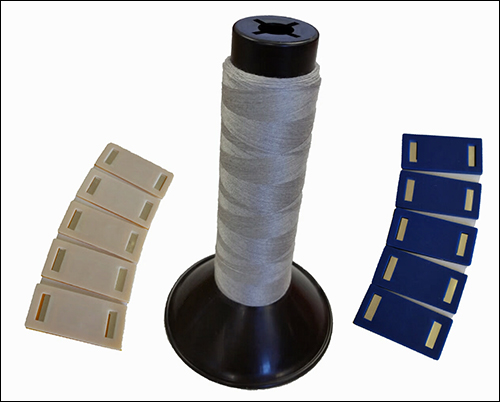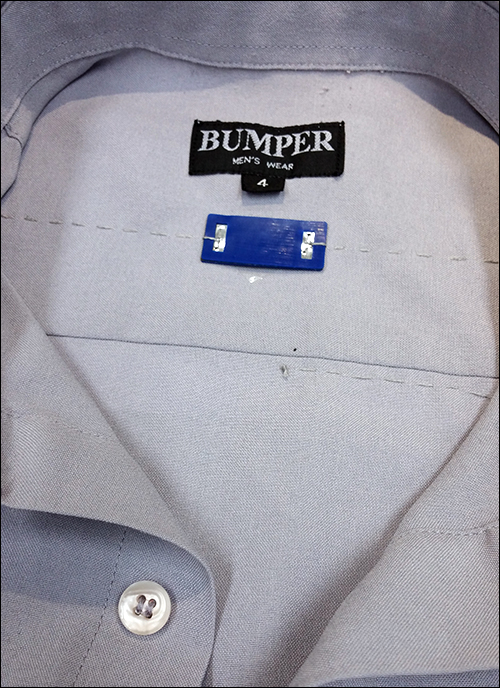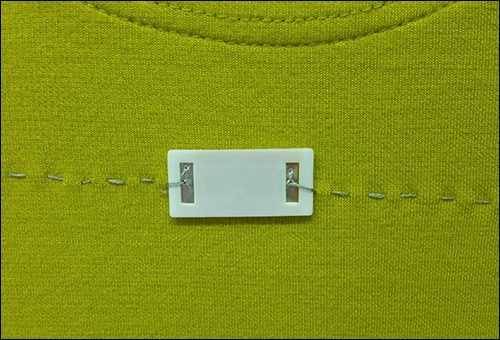Aug 28, 2015Farbo Uniforms, a Hong Kong uniform provider, reports that it is developing garment-tracking solutions based on a novel passive ultrahigh-frequency (UHF) EPC Gen 2 RFID tag with an antenna made of metalized thread. The tag, known as the CS8200, was developed by Convergence Systems Ltd. (CSL) and is unique in that the antenna is added after the tag is applied to a garment.
There are other tags on the market that use thin wires for antennas, but these are part of the tag, encased in protective material and applied to the garment. The CS8200 tag is different in that it includes two metal pads, one on each side. The thread—which creates a dipole tag antenna—is added after a tag is placed on a garment, with metalized thread stitched into each pad, as well as a garment or other cloth item, in either a straight or wave pattern. The tag is then sewn to the garment, or affixed via heat-sealed tape. The tag itself measures 17 millimeters by 34 millimeters by 1.4 millimeters (0.7 inch by 1.3 inches by 0.06 inch). The total length of the tag's thread antenna can be 60 millimeters, 100 millimeters or 140 millimeters (2.4 inches, 3.9 inches or 5.5 inches), depending on the desired read range.
The CS8200 tag is more durable, flexible and versatile—as well as less expensive—than other garment tags on the market, according to Jerry Garrett, CSL's managing director. The use of a metalized thread as the antenna enables the tag to be more flexible, since the tag does not need to house and protect a built-in antenna.
Made with the Ucode 7 chip from NXP Semiconductors, the CS8200 offers a read range of 2.7 meters (9 feet) with a 140-millimeter antenna, 1.1 meters (3.6 feet) with a 100-millimeter antenna, and 0.6 meter (2 feet) with a 60-millimeter antenna. The metalized antenna thread is available in a variety of customized colors, depending on a customer's needs. CSL offers sewing guidelines to help users ensure that they have it sewn properly to achieve the best read range. The metalized thread was developed specifically for use with the CSL tag by Coats, a manufacturer of industrial thread.
Farbo Uniforms provides costumes and uniforms for customers in Hong Kong, China and Macau, as well as management software and solutions to help customers monitor the movements and usage of clothing items. The company partners with Novus Motion, a firm that offers RFID solutions for the hospitality industry and other businesses that use uniforms and costumes, explains Jeffrey Chau, who serves as Farbo Uniforms' executive director and Novus Motion's director.
Farbo had sought a tag that could withstand the environment of laundry and dry cleaning, and that was low enough in cost to be offered to customers in high volumes. Most existing laundry tags claim to be able to sustain 200 wash cycles, Garrett says, though he argues that the drying cycle can shorten that lifetime considerably.
Chau says Farbo has put the tag through considerable testing at the company's laundry lab, co-operated by Laundry Blue. First, the firm sewed the tags to the inside back yoke of uniform labels, as well as in the bottom hem of each item. It then put the tagged garments through more than 150 cycles of industrial washing and subsequent drying, using Girbau Industrial HS-6 washing and drying units. The washing process consisted of a single 20-minute wash at 45 degrees Celsius (113 degrees Fahrenheit), two rinsing cycles and a four-minute spin at 1,000 revolutions per minute. Tumble-drying at 75 degrees Celsius (167 degrees Fahrenheit) for 30 minutes was followed by hot-steam pressing at 90 degrees Celsius (194 degrees Fahrenheit).

Following that process, Chau says, the tags were still readable via a CS101-4(SRRC) handheld reader. The company has also conducted testing with the tag protected by a heat-transfer film to determine whether the enhanced durability would ensure that it could survive chemicals such as those used by dry cleaners. Those tests are still underway.
According to Chau, Farbo intends to continue testing the tag with a wider range of reader hardware in a variety of environments before incorporating it in a solution that it would then offer to its customers. In the meantime, he says, Farbo is in conversations with several customers about offering the RFID solution to track garments. "We are exploring the use of this tag for Ocean Park Hong Kong for their costumes and uniform rental and laundry services," he says. Farbo is also speaking with UNICEF Hong Kong, as well as casinos in Macau.
CSL is offering a Metalized Thread Evaluation Kit that includes a 1,000-meter spool of metalized thread, as well as 10 CS8200 tags and heat-seal tape for applying the tags to clothing. What's more, the company is in discussions with other potential customers that could use the tags to track garments and other items, focusing initially on those that purchase products from Coats.



